No Hayes in this Barn
Granby (Google Maps Location)
July 2008
This is one of several Salmon Brook Historical Society Museums.
Neither my blurry pictures nor the Salmon Brook Historical Society’s website (they own the joint) do this place any amount of justice. The Colton-Hayes Tobacco Barn is the largest and most impressive part of the quartet of Granby historical buildings I visited in succession. I went in not expecting much more than a few old tools and some dried up tobacco leaves hanging from the rafters.
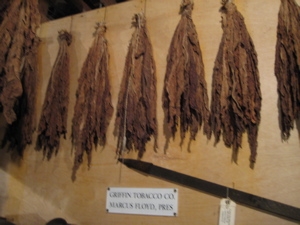
I got old tools and I got old tobacco, sure, but there is so much more. A TON more it turns out. Parts of this write-up are lifted from the historical society’s website. The large tobacco barn, built in 1914 by Fred M. Colton, was given to the historical society by his daughters in 1976.
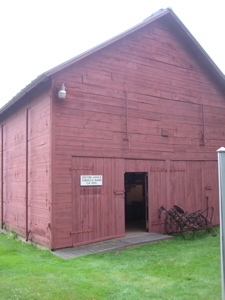
The Barn displays are a microcosm of Granby’s past. I was amazed at the diversity and volume of items here. The barn just seemed to keep on going and going and going… A cabinet houses a fine exhibit of local Indian artifacts. A large collection of early quilting, spinning, and weaving tools includes a rare Connecticut spinning wheel. Another corner is devoted to the Civil War memorabilia of Col. Richard E. Holcomb.
Who? That’s what I said and that’s what I asked Google. Google said,
As a child, Richard lived in the Turkey Hills (East Granby) section of Granby, in the big family home on Hartford Avenue. He was educated in local schools, including a private Academy. His life was adventurous and he traveled extensively in his work. For nearly ten years (1845-1855) he worked on the Isthmus of Panama, drawing maps, planning grades, and building bridges for the Panama Railroad. With his brothers, Franklin Porteous and Henry Lyman, he build the bridge across the Savannah River at Savannah, Georgia, using slave labor. His name is the first listed on the Granby Civil War Monument.
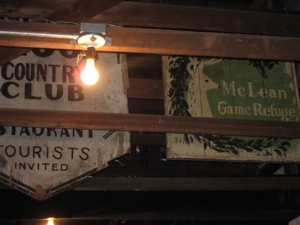
Inside the barn, an early Meeting House is recreated from many of Granby’s early churches. Doors from the Episcopal church of 1790, a Universalist Church pew, the First Church organ, South Church hymn boards, West Granby Methodist Church pew doors, and a Swedish Bible from the early days of Pilgrim Congregational… To give an idea of how big this barn museum is, there really is a section that is more or less a small church.
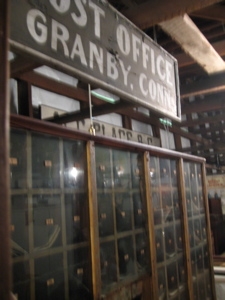
The rest of the Barn shows Granby in the 1890 era. A Village Store is filled with an amazing variety of items. There is a dressmaker’s shop, a shoemaker’s shop, and a creamery. The kitchen features an apple peeler, a sausage stuffer, an iron cookstove and an olde timey coffee mill. A wash kitchen has an 1830 zinc bathtub with a wooden lid, a stove to heat the heavy flat irons, and a hand cranked washing machine.
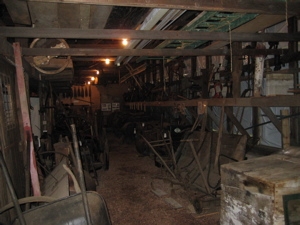
The back half of the Barn has a variety of exhibits from Granby’s rural heritage. There are farm tools and machinery, sleds and sleighs, a huge hoisting wheel, hay rakes and hay forks, carpenter tools, and items used in cider mills, grist mills, blacksmithing, maple sugaring, hog slaughtering, bee keeping, harness making, ice cutting and tobacco harvesting. Also on display is Granby’s first fire fighting equipment, a colorful voting booth and the beautiful horse drawn, glass-sided Hayes hearse.
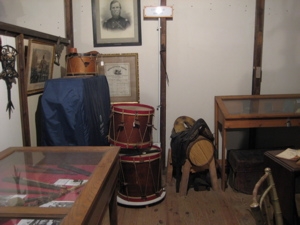
Most of the preceding descriptions are their website’s words. During my tour, ably given by Charlie Dickson of the historical society, I mentioned how they really need to brag a little more on their website. He agreed and it appears he heeded my sage advice, as there are now far more descriptive explanations.
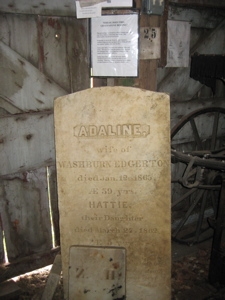
While I certainly enjoyed the other properties and tours during my trip to Granby, the Barn is by far the highlight. In the country store section mentioned above, it really is pretty much a country store from 100 and some years ago. Not just a few knick-knacks, but whole array of household goods and sundries – enough to get you through a month I’d say. Heck, I know where I’m going to hideout in Survival Mode when the entire economy collapses, society breaks down, and the ice caps melt – the Colton-Hayes Tobacco Barn!
[2018 Update: note to self about this place again.]
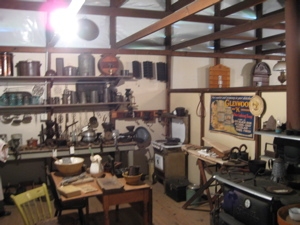
My post-apocalypse kitchen!
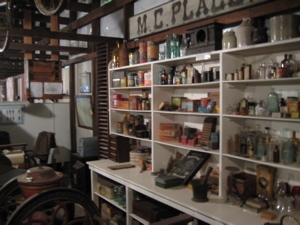
My post-apocalypse pantry
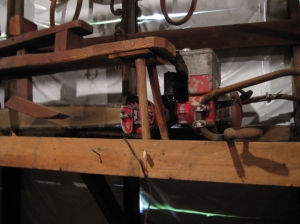
My post-apocalypse chainsaw!
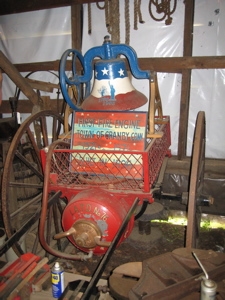
My post-apocalypse fire engine

My post-apocalypse toilet.
There are plenty of beds for my family, a few stoves, some freeze-dried food, canned goods, clothes, books, and farming tools with which to sow the fertile land. I’m all set and I’ve staked my claim – so stay away! Or I’ll ice-harvest tool you to death.
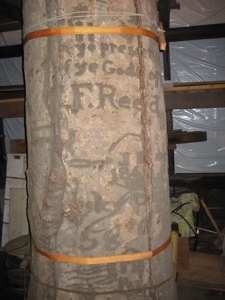
This is cool… thanks to the historical society’s comment below…
This is a beech tree that grew in the West Granby hills and was carved and decorated with initials, dates, flags, cannon, tent etc. by local young men who served in the Civil War. The tree died and they were able to acquire it for the Museum. According to them, “I think we are the only Historical Society to have a tree.”
I have no idea how that claim would be verified, but let’s go with it. After all, Granby knows a thing or two about cool trees.
![]()
Salmon Brook Historical Society
CTMQ’s Museum Visits

 Carol Laun, Curator/Archivist says
Carol Laun, Curator/Archivist says
October 17, 2010 at 9:49 pmI appreciate your glowing description of our Barn Museum, but I do want to correct one error. There is a second gravestone that had an incorrect date, but what you call a “tree-trunk looking thing” is actually a tree trunk. It is a beech tree that grew in the West Granby hills and was carved and decorated with initials, dates, flags, cannon, tent etc. by local young men who served in the Civil War. The tree died and we were able to acquire it for our Museum. I think we are the only Historical Society to have a tree. It has been featured in the book of Notable Trees of Connecticut. Oh, and it now costs $4 to tour all the buildings. Come visit us again, we have added another barn and rearranged some exhibits.